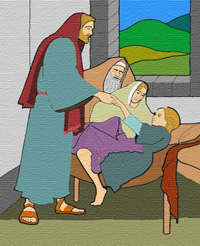
13th Sunday in Ordinary Time Year B
Mark concludes his account of the ministry of Jesus in Galilee with descriptions of some remarkable miracles worked by Jesus during this ministry. In today’s reading Jesus shows himself the Lord of life and death – healing the woman ‘who had suffered from a haemorrhage for twelve years’, and bringing back to life the young daughter of one of the elders of the local synagogue.
Again, the words of Jesus and Mark’s telling of the story emphasise the importance of ‘faith’ in what is to unfold – a trusting openness to the fact that, in the ministry of Jesus, God’s great promises to Israel were being fulfilled. This faith, however, finds very different expression in the two cases. The synagogue official, well versed in the traditions of Israel, and with an openness that expresses the true spirit of Israel’s faith, makes his request: ‘Make my little daughter better and save her life’. His trust in what Jesus can do for him is in stark contrast with the attitude of those who report that the girl is already dead and urge him not to trouble Jesus further, and with the mourners already gathering in his home. The woman’s faith is less informed; naïve perhaps, very like the faith of so many simple believers. But what she knows of Jesus inspires her to seek a healing by ‘touching his clothes’. The reaction of Jesus is to lead her to the personal meeting with him that should take place in an authentic faith.
As was the case with the miracle story which precedes this one – in which Jesus shows his Lordship by quelling the storm – the community for which Mark wrote his gospel would have listened to this narrative, in which Jesus showed himself Lord of life and death, against the background of their faith in his resurrection – the ultimate demonstration of this Lordship. This is confirmed, commentators point out, by the fact that, in the telling of the miraculous events , terms are used which echo New Testament faith in the resurrection: ‘Lay your hands on her that she may be healed and live’; ‘Your faith has healed you’ (The Greek could also be translated, ‘saved’, a powerful word in the vocabulary of Christian faith); ‘Little gift I tell you arise’ (This Greek word is often used in reference to the Lord’s resurrection). Against this background, the many reference to ‘life’ take on a deeper meaning.
This gospel narrative sheds light on the attitudes of Jesus. The two miracles, both worked for women, show the freedom with which he related to the customs that had grown up in old Israel. According to these customs, the woman’s ailment would have made her ‘unclean’ – and perhaps that is why, when summoned by Jesus, she ‘came forward frightened and trembling’, concerned that she may have offended him. But her fears were brushed aside by the Saviour who came to bring authentic fulfilment to all that the life of old Israel foreshadowed; ‘My daughter your faith has restored you to health; go in peace’. In bringing the little girl back to life, Jesus ‘took her by the hand’. This was a remarkable thing to do. According to Jewish customs it was not acceptable for a man to touch a twelve year old girl – since she was now of marriageable age.
John Thornhill sm

